Office Management Report: Legal, Procedures, and Meetings Analysis
VerifiedAdded on 2020/06/04
|14
|2402
|66
Report
AI Summary
This report comprehensively addresses various facets of office management, commencing with an introduction that underscores the significance of effective office arrangements for smooth business operations. It then delves into legal requirements, service facilities, and procedures for office management, along with resource management techniques. The report further explores workflow management, support facilities for workers, and health and safety obligations. It elaborates on meeting minutes, formal and informal meeting types, and the roles of chairpersons and participants. Additionally, it discusses techniques to facilitate meetings, manage workloads through targets and budgets, and allocate work effectively. Quality management techniques, improvement identification, and event management characteristics are also analyzed. The report concludes by emphasizing the importance of office management for organizational success.

Paraphrase This Document
Need a fresh take? Get an instant paraphrase of this document with our AI Paraphraser

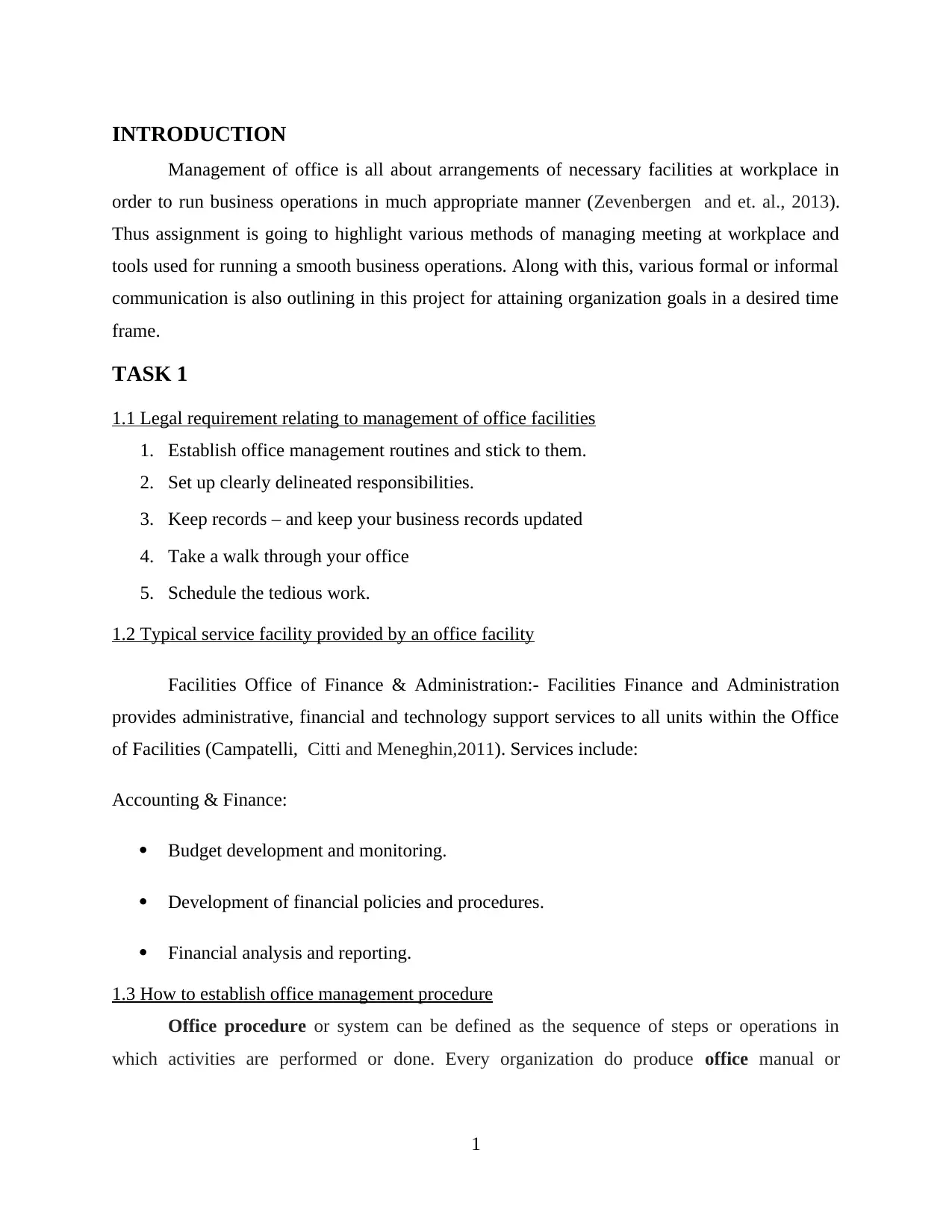
INTRODUCTION
Management of office is all about arrangements of necessary facilities at workplace in
order to run business operations in much appropriate manner (Zevenbergen and et. al., 2013).
Thus assignment is going to highlight various methods of managing meeting at workplace and
tools used for running a smooth business operations. Along with this, various formal or informal
communication is also outlining in this project for attaining organization goals in a desired time
frame.
TASK 1
1.1 Legal requirement relating to management of office facilities
1. Establish office management routines and stick to them.
2. Set up clearly delineated responsibilities.
3. Keep records – and keep your business records updated
4. Take a walk through your office
5. Schedule the tedious work.
1.2 Typical service facility provided by an office facility
Facilities Office of Finance & Administration:- Facilities Finance and Administration
provides administrative, financial and technology support services to all units within the Office
of Facilities (Campatelli, Citti and Meneghin,2011). Services include:
Accounting & Finance:
Budget development and monitoring.
Development of financial policies and procedures.
Financial analysis and reporting.
1.3 How to establish office management procedure
Office procedure or system can be defined as the sequence of steps or operations in
which activities are performed or done. Every organization do produce office manual or
1
Management of office is all about arrangements of necessary facilities at workplace in
order to run business operations in much appropriate manner (Zevenbergen and et. al., 2013).
Thus assignment is going to highlight various methods of managing meeting at workplace and
tools used for running a smooth business operations. Along with this, various formal or informal
communication is also outlining in this project for attaining organization goals in a desired time
frame.
TASK 1
1.1 Legal requirement relating to management of office facilities
1. Establish office management routines and stick to them.
2. Set up clearly delineated responsibilities.
3. Keep records – and keep your business records updated
4. Take a walk through your office
5. Schedule the tedious work.
1.2 Typical service facility provided by an office facility
Facilities Office of Finance & Administration:- Facilities Finance and Administration
provides administrative, financial and technology support services to all units within the Office
of Facilities (Campatelli, Citti and Meneghin,2011). Services include:
Accounting & Finance:
Budget development and monitoring.
Development of financial policies and procedures.
Financial analysis and reporting.
1.3 How to establish office management procedure
Office procedure or system can be defined as the sequence of steps or operations in
which activities are performed or done. Every organization do produce office manual or
1
⊘ This is a preview!⊘
Do you want full access?
Subscribe today to unlock all pages.

Trusted by 1+ million students worldwide
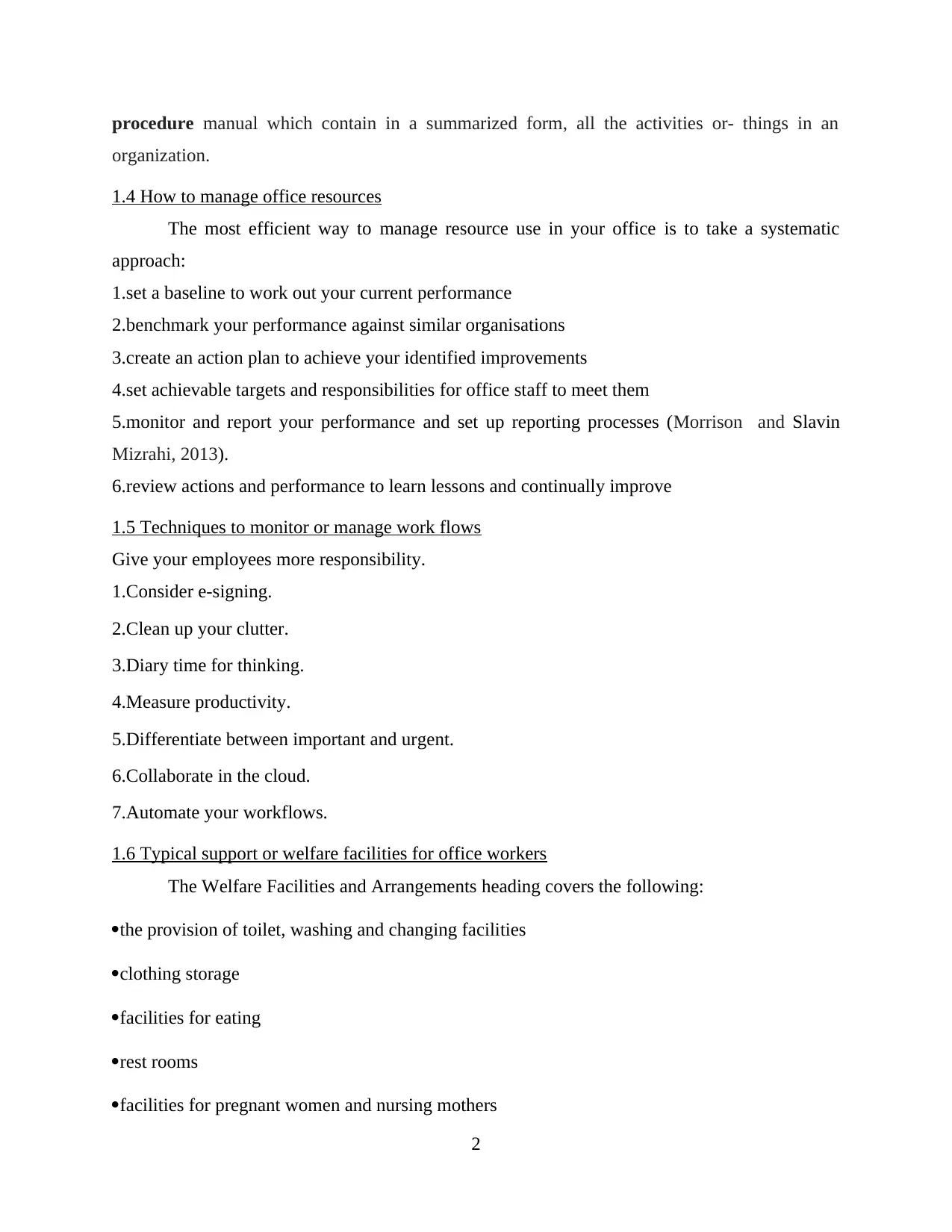
procedure manual which contain in a summarized form, all the activities or- things in an
organization.
1.4 How to manage office resources
The most efficient way to manage resource use in your office is to take a systematic
approach:
1.set a baseline to work out your current performance
2.benchmark your performance against similar organisations
3.create an action plan to achieve your identified improvements
4.set achievable targets and responsibilities for office staff to meet them
5.monitor and report your performance and set up reporting processes (Morrison and Slavin
Mizrahi, 2013).
6.review actions and performance to learn lessons and continually improve
1.5 Techniques to monitor or manage work flows
Give your employees more responsibility.
1.Consider e-signing.
2.Clean up your clutter.
3.Diary time for thinking.
4.Measure productivity.
5.Differentiate between important and urgent.
6.Collaborate in the cloud.
7.Automate your workflows.
1.6 Typical support or welfare facilities for office workers
The Welfare Facilities and Arrangements heading covers the following:
the provision of toilet, washing and changing facilities
clothing storage
facilities for eating
rest rooms
facilities for pregnant women and nursing mothers
2
organization.
1.4 How to manage office resources
The most efficient way to manage resource use in your office is to take a systematic
approach:
1.set a baseline to work out your current performance
2.benchmark your performance against similar organisations
3.create an action plan to achieve your identified improvements
4.set achievable targets and responsibilities for office staff to meet them
5.monitor and report your performance and set up reporting processes (Morrison and Slavin
Mizrahi, 2013).
6.review actions and performance to learn lessons and continually improve
1.5 Techniques to monitor or manage work flows
Give your employees more responsibility.
1.Consider e-signing.
2.Clean up your clutter.
3.Diary time for thinking.
4.Measure productivity.
5.Differentiate between important and urgent.
6.Collaborate in the cloud.
7.Automate your workflows.
1.6 Typical support or welfare facilities for office workers
The Welfare Facilities and Arrangements heading covers the following:
the provision of toilet, washing and changing facilities
clothing storage
facilities for eating
rest rooms
facilities for pregnant women and nursing mothers
2
Paraphrase This Document
Need a fresh take? Get an instant paraphrase of this document with our AI Paraphraser
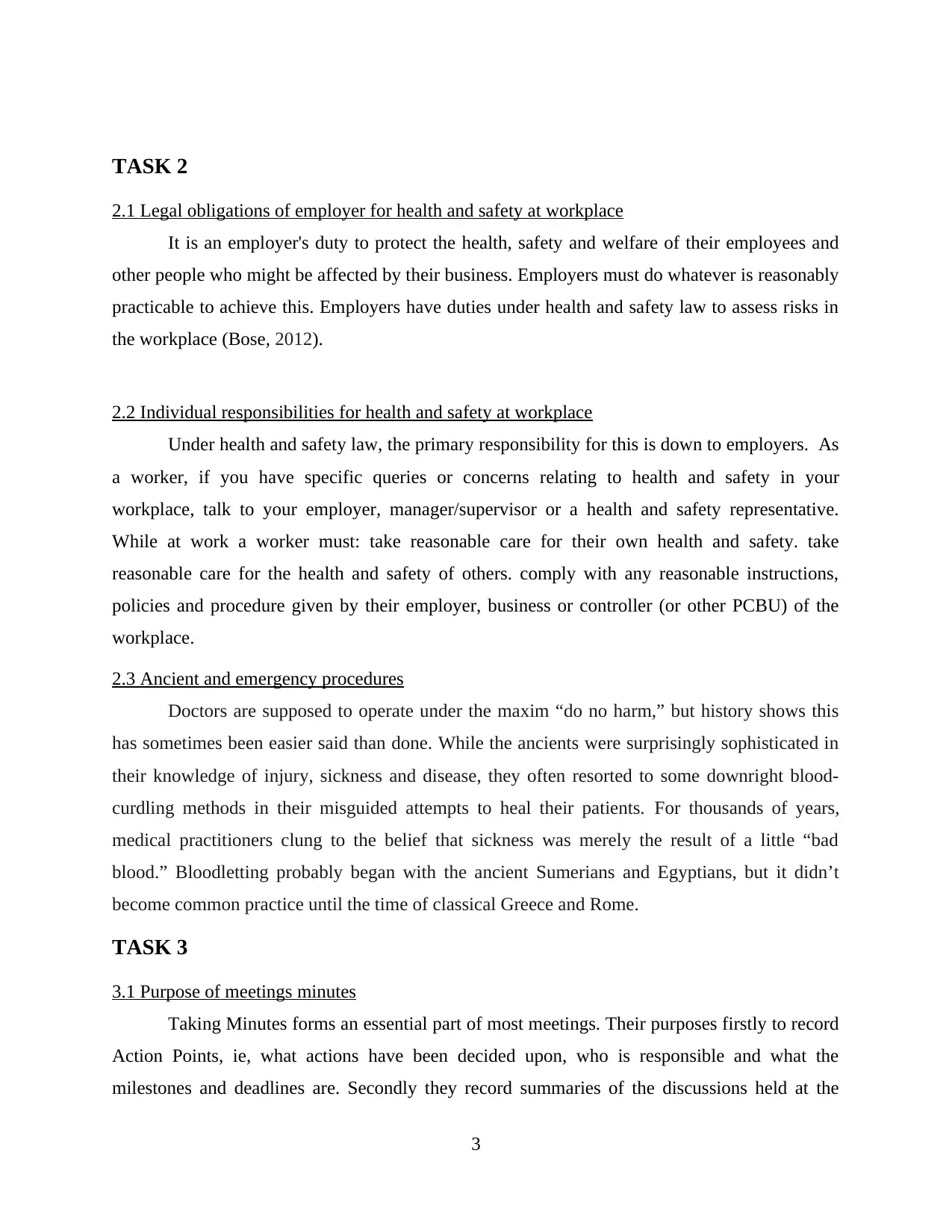
TASK 2
2.1 Legal obligations of employer for health and safety at workplace
It is an employer's duty to protect the health, safety and welfare of their employees and
other people who might be affected by their business. Employers must do whatever is reasonably
practicable to achieve this. Employers have duties under health and safety law to assess risks in
the workplace (Bose, 2012).
2.2 Individual responsibilities for health and safety at workplace
Under health and safety law, the primary responsibility for this is down to employers. As
a worker, if you have specific queries or concerns relating to health and safety in your
workplace, talk to your employer, manager/supervisor or a health and safety representative.
While at work a worker must: take reasonable care for their own health and safety. take
reasonable care for the health and safety of others. comply with any reasonable instructions,
policies and procedure given by their employer, business or controller (or other PCBU) of the
workplace.
2.3 Ancient and emergency procedures
Doctors are supposed to operate under the maxim “do no harm,” but history shows this
has sometimes been easier said than done. While the ancients were surprisingly sophisticated in
their knowledge of injury, sickness and disease, they often resorted to some downright blood-
curdling methods in their misguided attempts to heal their patients. For thousands of years,
medical practitioners clung to the belief that sickness was merely the result of a little “bad
blood.” Bloodletting probably began with the ancient Sumerians and Egyptians, but it didn’t
become common practice until the time of classical Greece and Rome.
TASK 3
3.1 Purpose of meetings minutes
Taking Minutes forms an essential part of most meetings. Their purposes firstly to record
Action Points, ie, what actions have been decided upon, who is responsible and what the
milestones and deadlines are. Secondly they record summaries of the discussions held at the
3
2.1 Legal obligations of employer for health and safety at workplace
It is an employer's duty to protect the health, safety and welfare of their employees and
other people who might be affected by their business. Employers must do whatever is reasonably
practicable to achieve this. Employers have duties under health and safety law to assess risks in
the workplace (Bose, 2012).
2.2 Individual responsibilities for health and safety at workplace
Under health and safety law, the primary responsibility for this is down to employers. As
a worker, if you have specific queries or concerns relating to health and safety in your
workplace, talk to your employer, manager/supervisor or a health and safety representative.
While at work a worker must: take reasonable care for their own health and safety. take
reasonable care for the health and safety of others. comply with any reasonable instructions,
policies and procedure given by their employer, business or controller (or other PCBU) of the
workplace.
2.3 Ancient and emergency procedures
Doctors are supposed to operate under the maxim “do no harm,” but history shows this
has sometimes been easier said than done. While the ancients were surprisingly sophisticated in
their knowledge of injury, sickness and disease, they often resorted to some downright blood-
curdling methods in their misguided attempts to heal their patients. For thousands of years,
medical practitioners clung to the belief that sickness was merely the result of a little “bad
blood.” Bloodletting probably began with the ancient Sumerians and Egyptians, but it didn’t
become common practice until the time of classical Greece and Rome.
TASK 3
3.1 Purpose of meetings minutes
Taking Minutes forms an essential part of most meetings. Their purposes firstly to record
Action Points, ie, what actions have been decided upon, who is responsible and what the
milestones and deadlines are. Secondly they record summaries of the discussions held at the
3
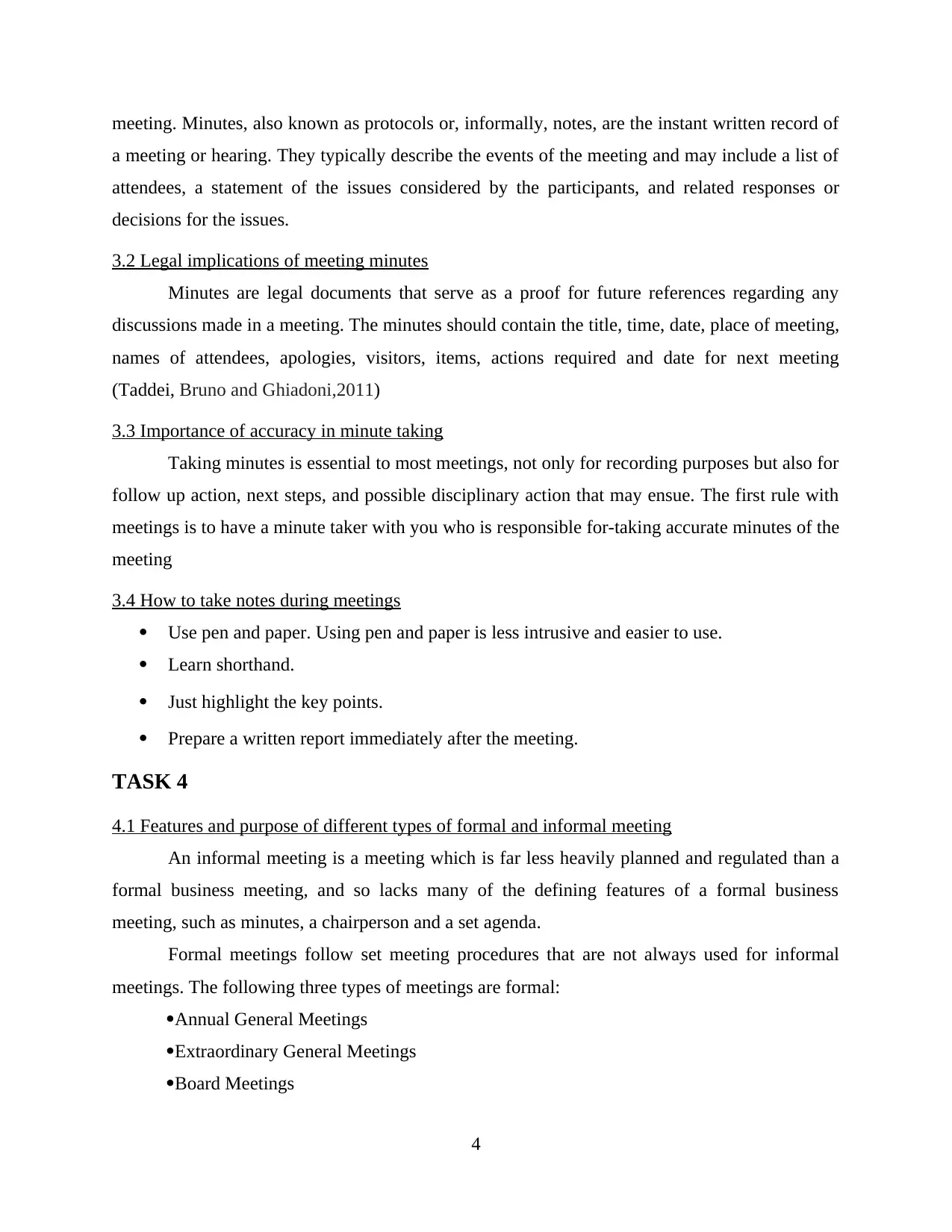
meeting. Minutes, also known as protocols or, informally, notes, are the instant written record of
a meeting or hearing. They typically describe the events of the meeting and may include a list of
attendees, a statement of the issues considered by the participants, and related responses or
decisions for the issues.
3.2 Legal implications of meeting minutes
Minutes are legal documents that serve as a proof for future references regarding any
discussions made in a meeting. The minutes should contain the title, time, date, place of meeting,
names of attendees, apologies, visitors, items, actions required and date for next meeting
(Taddei, Bruno and Ghiadoni,2011)
3.3 Importance of accuracy in minute taking
Taking minutes is essential to most meetings, not only for recording purposes but also for
follow up action, next steps, and possible disciplinary action that may ensue. The first rule with
meetings is to have a minute taker with you who is responsible for-taking accurate minutes of the
meeting
3.4 How to take notes during meetings
Use pen and paper. Using pen and paper is less intrusive and easier to use.
Learn shorthand.
Just highlight the key points.
Prepare a written report immediately after the meeting.
TASK 4
4.1 Features and purpose of different types of formal and informal meeting
An informal meeting is a meeting which is far less heavily planned and regulated than a
formal business meeting, and so lacks many of the defining features of a formal business
meeting, such as minutes, a chairperson and a set agenda.
Formal meetings follow set meeting procedures that are not always used for informal
meetings. The following three types of meetings are formal:
Annual General Meetings
Extraordinary General Meetings
Board Meetings
4
a meeting or hearing. They typically describe the events of the meeting and may include a list of
attendees, a statement of the issues considered by the participants, and related responses or
decisions for the issues.
3.2 Legal implications of meeting minutes
Minutes are legal documents that serve as a proof for future references regarding any
discussions made in a meeting. The minutes should contain the title, time, date, place of meeting,
names of attendees, apologies, visitors, items, actions required and date for next meeting
(Taddei, Bruno and Ghiadoni,2011)
3.3 Importance of accuracy in minute taking
Taking minutes is essential to most meetings, not only for recording purposes but also for
follow up action, next steps, and possible disciplinary action that may ensue. The first rule with
meetings is to have a minute taker with you who is responsible for-taking accurate minutes of the
meeting
3.4 How to take notes during meetings
Use pen and paper. Using pen and paper is less intrusive and easier to use.
Learn shorthand.
Just highlight the key points.
Prepare a written report immediately after the meeting.
TASK 4
4.1 Features and purpose of different types of formal and informal meeting
An informal meeting is a meeting which is far less heavily planned and regulated than a
formal business meeting, and so lacks many of the defining features of a formal business
meeting, such as minutes, a chairperson and a set agenda.
Formal meetings follow set meeting procedures that are not always used for informal
meetings. The following three types of meetings are formal:
Annual General Meetings
Extraordinary General Meetings
Board Meetings
4
⊘ This is a preview!⊘
Do you want full access?
Subscribe today to unlock all pages.

Trusted by 1+ million students worldwide
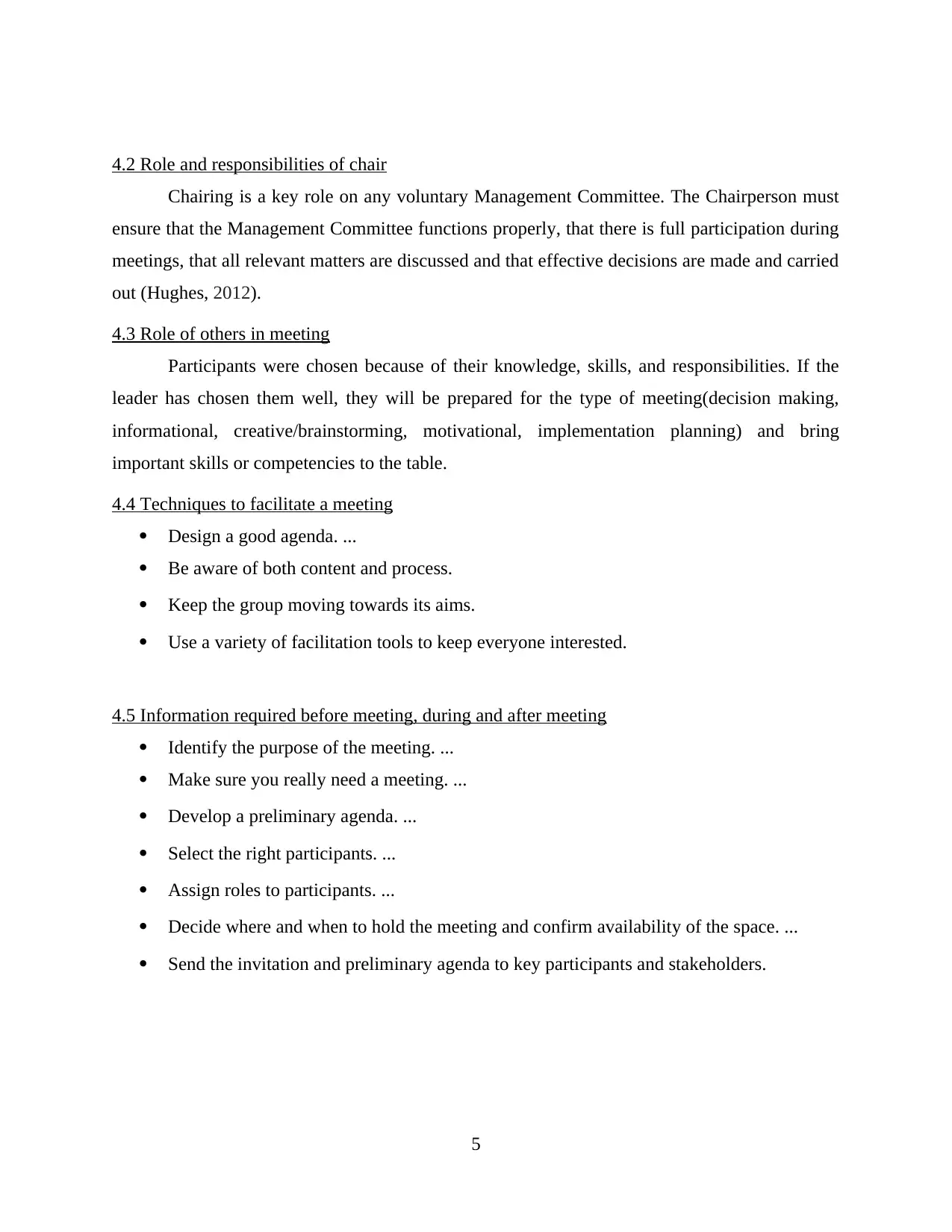
4.2 Role and responsibilities of chair
Chairing is a key role on any voluntary Management Committee. The Chairperson must
ensure that the Management Committee functions properly, that there is full participation during
meetings, that all relevant matters are discussed and that effective decisions are made and carried
out (Hughes, 2012).
4.3 Role of others in meeting
Participants were chosen because of their knowledge, skills, and responsibilities. If the
leader has chosen them well, they will be prepared for the type of meeting(decision making,
informational, creative/brainstorming, motivational, implementation planning) and bring
important skills or competencies to the table.
4.4 Techniques to facilitate a meeting
Design a good agenda. ...
Be aware of both content and process.
Keep the group moving towards its aims.
Use a variety of facilitation tools to keep everyone interested.
4.5 Information required before meeting, during and after meeting
Identify the purpose of the meeting. ...
Make sure you really need a meeting. ...
Develop a preliminary agenda. ...
Select the right participants. ...
Assign roles to participants. ...
Decide where and when to hold the meeting and confirm availability of the space. ...
Send the invitation and preliminary agenda to key participants and stakeholders.
5
Chairing is a key role on any voluntary Management Committee. The Chairperson must
ensure that the Management Committee functions properly, that there is full participation during
meetings, that all relevant matters are discussed and that effective decisions are made and carried
out (Hughes, 2012).
4.3 Role of others in meeting
Participants were chosen because of their knowledge, skills, and responsibilities. If the
leader has chosen them well, they will be prepared for the type of meeting(decision making,
informational, creative/brainstorming, motivational, implementation planning) and bring
important skills or competencies to the table.
4.4 Techniques to facilitate a meeting
Design a good agenda. ...
Be aware of both content and process.
Keep the group moving towards its aims.
Use a variety of facilitation tools to keep everyone interested.
4.5 Information required before meeting, during and after meeting
Identify the purpose of the meeting. ...
Make sure you really need a meeting. ...
Develop a preliminary agenda. ...
Select the right participants. ...
Assign roles to participants. ...
Decide where and when to hold the meeting and confirm availability of the space. ...
Send the invitation and preliminary agenda to key participants and stakeholders.
5
Paraphrase This Document
Need a fresh take? Get an instant paraphrase of this document with our AI Paraphraser
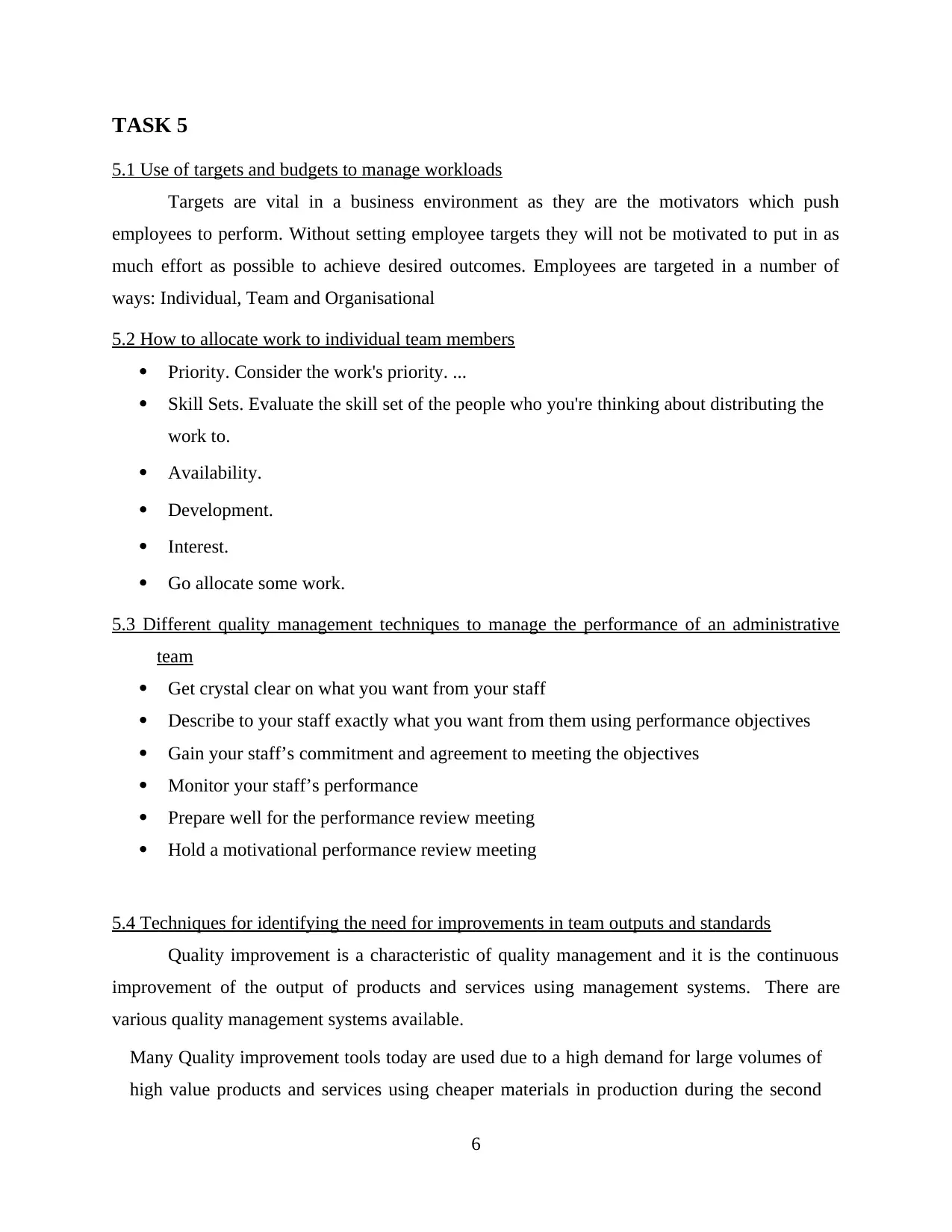
TASK 5
5.1 Use of targets and budgets to manage workloads
Targets are vital in a business environment as they are the motivators which push
employees to perform. Without setting employee targets they will not be motivated to put in as
much effort as possible to achieve desired outcomes. Employees are targeted in a number of
ways: Individual, Team and Organisational
5.2 How to allocate work to individual team members
Priority. Consider the work's priority. ...
Skill Sets. Evaluate the skill set of the people who you're thinking about distributing the
work to.
Availability.
Development.
Interest.
Go allocate some work.
5.3 Different quality management techniques to manage the performance of an administrative
team
Get crystal clear on what you want from your staff
Describe to your staff exactly what you want from them using performance objectives
Gain your staff’s commitment and agreement to meeting the objectives
Monitor your staff’s performance
Prepare well for the performance review meeting
Hold a motivational performance review meeting
5.4 Techniques for identifying the need for improvements in team outputs and standards
Quality improvement is a characteristic of quality management and it is the continuous
improvement of the output of products and services using management systems. There are
various quality management systems available.
Many Quality improvement tools today are used due to a high demand for large volumes of
high value products and services using cheaper materials in production during the second
6
5.1 Use of targets and budgets to manage workloads
Targets are vital in a business environment as they are the motivators which push
employees to perform. Without setting employee targets they will not be motivated to put in as
much effort as possible to achieve desired outcomes. Employees are targeted in a number of
ways: Individual, Team and Organisational
5.2 How to allocate work to individual team members
Priority. Consider the work's priority. ...
Skill Sets. Evaluate the skill set of the people who you're thinking about distributing the
work to.
Availability.
Development.
Interest.
Go allocate some work.
5.3 Different quality management techniques to manage the performance of an administrative
team
Get crystal clear on what you want from your staff
Describe to your staff exactly what you want from them using performance objectives
Gain your staff’s commitment and agreement to meeting the objectives
Monitor your staff’s performance
Prepare well for the performance review meeting
Hold a motivational performance review meeting
5.4 Techniques for identifying the need for improvements in team outputs and standards
Quality improvement is a characteristic of quality management and it is the continuous
improvement of the output of products and services using management systems. There are
various quality management systems available.
Many Quality improvement tools today are used due to a high demand for large volumes of
high value products and services using cheaper materials in production during the second
6
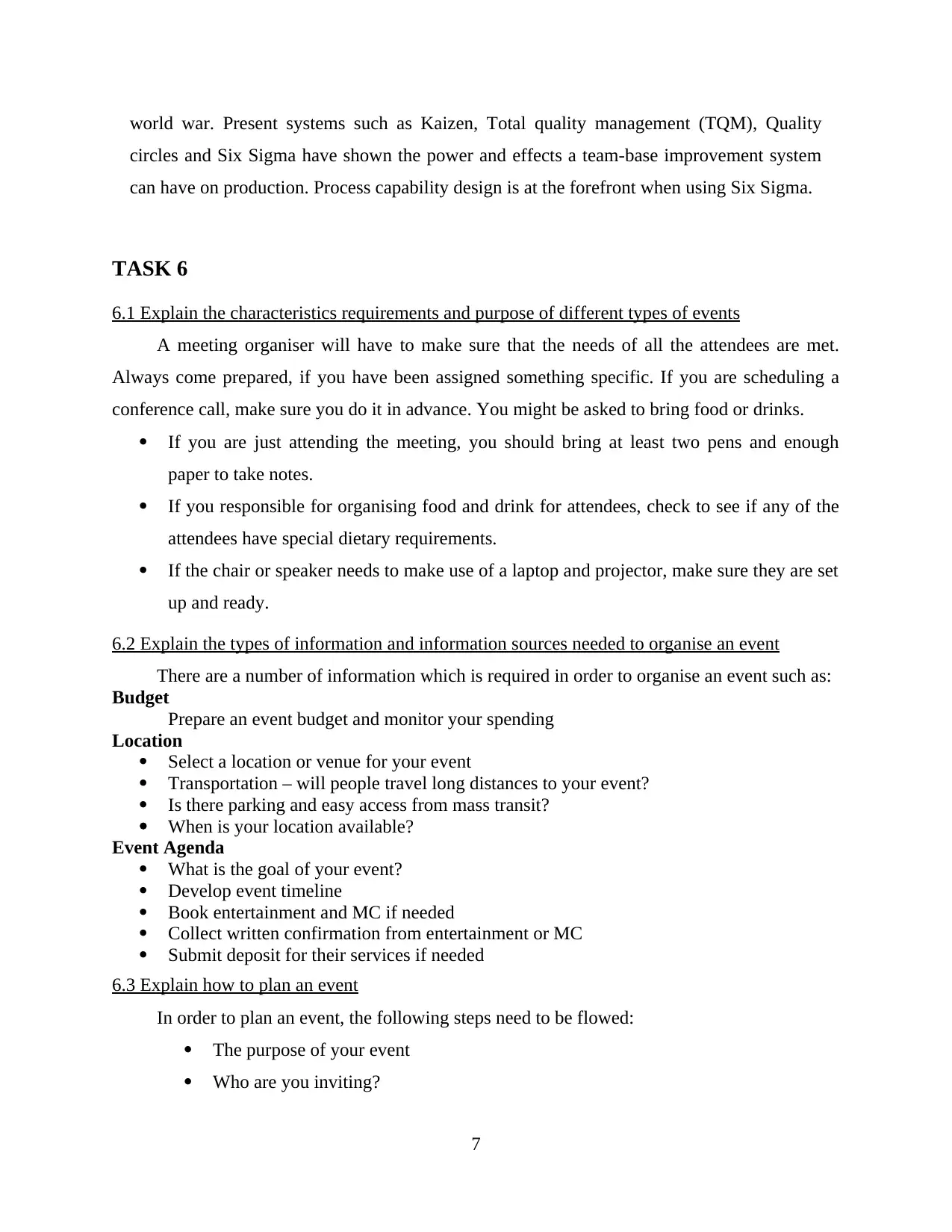
world war. Present systems such as Kaizen, Total quality management (TQM), Quality
circles and Six Sigma have shown the power and effects a team-base improvement system
can have on production. Process capability design is at the forefront when using Six Sigma.
TASK 6
6.1 Explain the characteristics requirements and purpose of different types of events
A meeting organiser will have to make sure that the needs of all the attendees are met.
Always come prepared, if you have been assigned something specific. If you are scheduling a
conference call, make sure you do it in advance. You might be asked to bring food or drinks.
If you are just attending the meeting, you should bring at least two pens and enough
paper to take notes.
If you responsible for organising food and drink for attendees, check to see if any of the
attendees have special dietary requirements.
If the chair or speaker needs to make use of a laptop and projector, make sure they are set
up and ready.
6.2 Explain the types of information and information sources needed to organise an event
There are a number of information which is required in order to organise an event such as:
Budget
Prepare an event budget and monitor your spending
Location
Select a location or venue for your event
Transportation – will people travel long distances to your event?
Is there parking and easy access from mass transit?
When is your location available?
Event Agenda
What is the goal of your event?
Develop event timeline
Book entertainment and MC if needed
Collect written confirmation from entertainment or MC
Submit deposit for their services if needed
6.3 Explain how to plan an event
In order to plan an event, the following steps need to be flowed:
The purpose of your event
Who are you inviting?
7
circles and Six Sigma have shown the power and effects a team-base improvement system
can have on production. Process capability design is at the forefront when using Six Sigma.
TASK 6
6.1 Explain the characteristics requirements and purpose of different types of events
A meeting organiser will have to make sure that the needs of all the attendees are met.
Always come prepared, if you have been assigned something specific. If you are scheduling a
conference call, make sure you do it in advance. You might be asked to bring food or drinks.
If you are just attending the meeting, you should bring at least two pens and enough
paper to take notes.
If you responsible for organising food and drink for attendees, check to see if any of the
attendees have special dietary requirements.
If the chair or speaker needs to make use of a laptop and projector, make sure they are set
up and ready.
6.2 Explain the types of information and information sources needed to organise an event
There are a number of information which is required in order to organise an event such as:
Budget
Prepare an event budget and monitor your spending
Location
Select a location or venue for your event
Transportation – will people travel long distances to your event?
Is there parking and easy access from mass transit?
When is your location available?
Event Agenda
What is the goal of your event?
Develop event timeline
Book entertainment and MC if needed
Collect written confirmation from entertainment or MC
Submit deposit for their services if needed
6.3 Explain how to plan an event
In order to plan an event, the following steps need to be flowed:
The purpose of your event
Who are you inviting?
7
⊘ This is a preview!⊘
Do you want full access?
Subscribe today to unlock all pages.

Trusted by 1+ million students worldwide
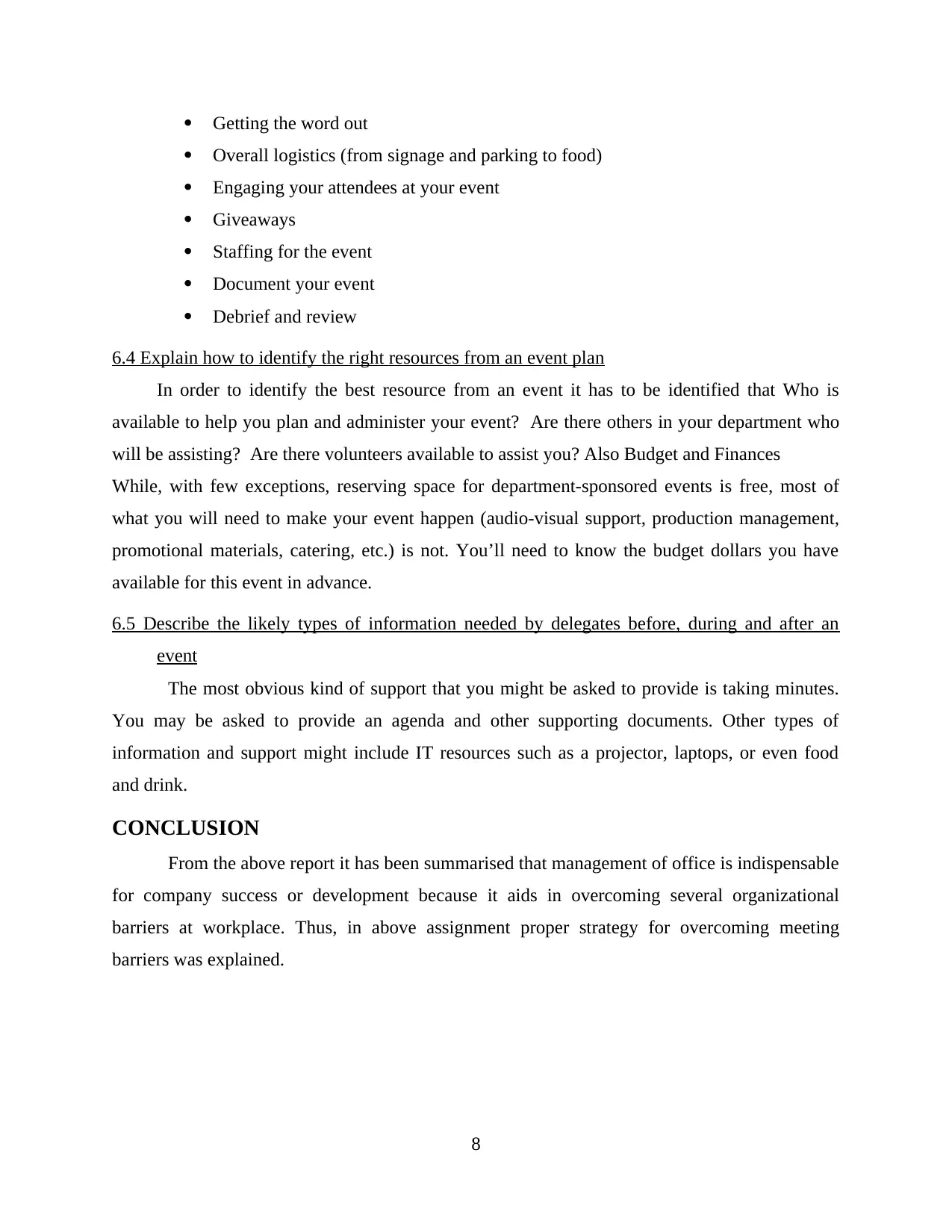
Getting the word out
Overall logistics (from signage and parking to food)
Engaging your attendees at your event
Giveaways
Staffing for the event
Document your event
Debrief and review
6.4 Explain how to identify the right resources from an event plan
In order to identify the best resource from an event it has to be identified that Who is
available to help you plan and administer your event? Are there others in your department who
will be assisting? Are there volunteers available to assist you? Also Budget and Finances
While, with few exceptions, reserving space for department-sponsored events is free, most of
what you will need to make your event happen (audio-visual support, production management,
promotional materials, catering, etc.) is not. You’ll need to know the budget dollars you have
available for this event in advance.
6.5 Describe the likely types of information needed by delegates before, during and after an
event
The most obvious kind of support that you might be asked to provide is taking minutes.
You may be asked to provide an agenda and other supporting documents. Other types of
information and support might include IT resources such as a projector, laptops, or even food
and drink.
CONCLUSION
From the above report it has been summarised that management of office is indispensable
for company success or development because it aids in overcoming several organizational
barriers at workplace. Thus, in above assignment proper strategy for overcoming meeting
barriers was explained.
8
Overall logistics (from signage and parking to food)
Engaging your attendees at your event
Giveaways
Staffing for the event
Document your event
Debrief and review
6.4 Explain how to identify the right resources from an event plan
In order to identify the best resource from an event it has to be identified that Who is
available to help you plan and administer your event? Are there others in your department who
will be assisting? Are there volunteers available to assist you? Also Budget and Finances
While, with few exceptions, reserving space for department-sponsored events is free, most of
what you will need to make your event happen (audio-visual support, production management,
promotional materials, catering, etc.) is not. You’ll need to know the budget dollars you have
available for this event in advance.
6.5 Describe the likely types of information needed by delegates before, during and after an
event
The most obvious kind of support that you might be asked to provide is taking minutes.
You may be asked to provide an agenda and other supporting documents. Other types of
information and support might include IT resources such as a projector, laptops, or even food
and drink.
CONCLUSION
From the above report it has been summarised that management of office is indispensable
for company success or development because it aids in overcoming several organizational
barriers at workplace. Thus, in above assignment proper strategy for overcoming meeting
barriers was explained.
8
Paraphrase This Document
Need a fresh take? Get an instant paraphrase of this document with our AI Paraphraser
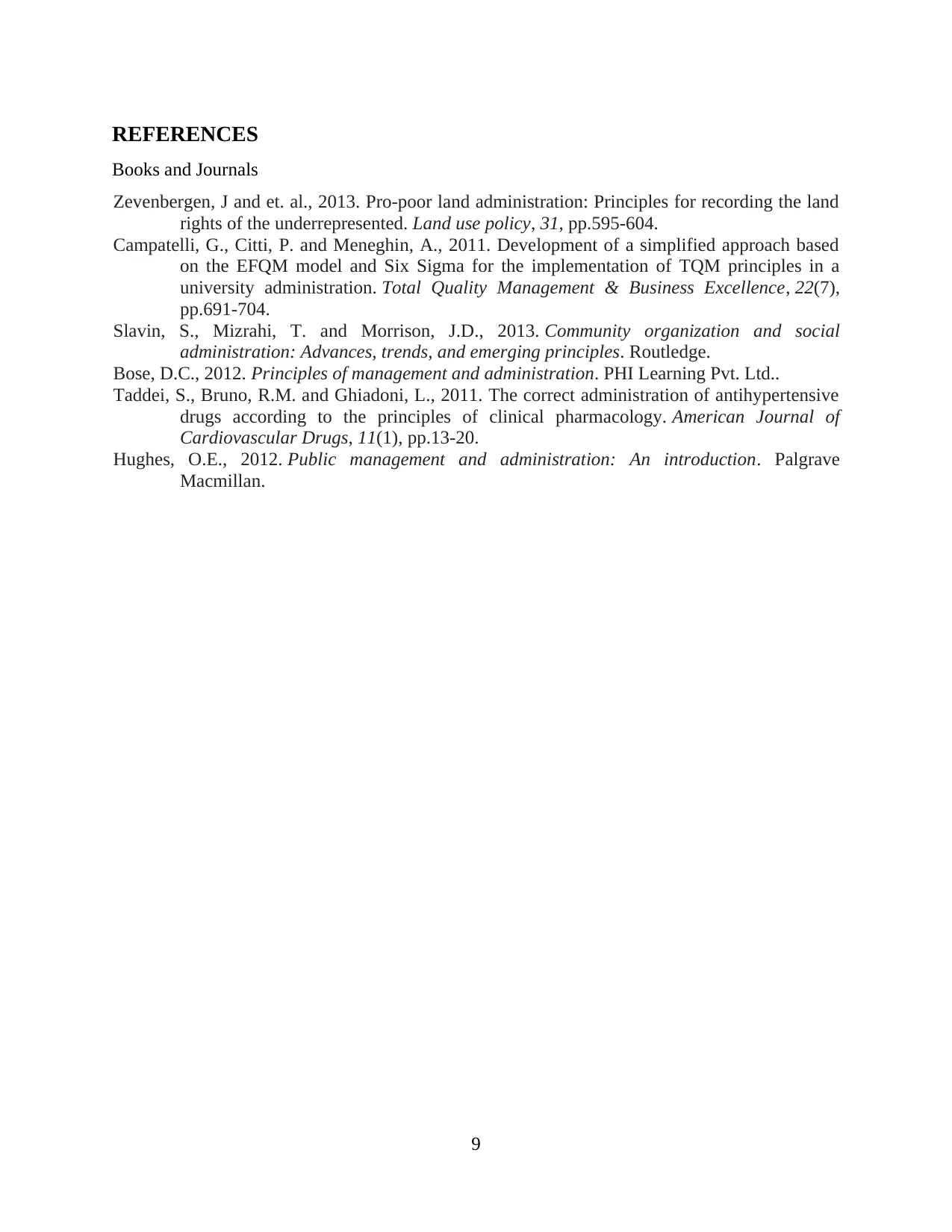
REFERENCES
Books and Journals
Zevenbergen, J and et. al., 2013. Pro-poor land administration: Principles for recording the land
rights of the underrepresented. Land use policy, 31, pp.595-604.
Campatelli, G., Citti, P. and Meneghin, A., 2011. Development of a simplified approach based
on the EFQM model and Six Sigma for the implementation of TQM principles in a
university administration. Total Quality Management & Business Excellence, 22(7),
pp.691-704.
Slavin, S., Mizrahi, T. and Morrison, J.D., 2013. Community organization and social
administration: Advances, trends, and emerging principles. Routledge.
Bose, D.C., 2012. Principles of management and administration. PHI Learning Pvt. Ltd..
Taddei, S., Bruno, R.M. and Ghiadoni, L., 2011. The correct administration of antihypertensive
drugs according to the principles of clinical pharmacology. American Journal of
Cardiovascular Drugs, 11(1), pp.13-20.
Hughes, O.E., 2012. Public management and administration: An introduction. Palgrave
Macmillan.
9
Books and Journals
Zevenbergen, J and et. al., 2013. Pro-poor land administration: Principles for recording the land
rights of the underrepresented. Land use policy, 31, pp.595-604.
Campatelli, G., Citti, P. and Meneghin, A., 2011. Development of a simplified approach based
on the EFQM model and Six Sigma for the implementation of TQM principles in a
university administration. Total Quality Management & Business Excellence, 22(7),
pp.691-704.
Slavin, S., Mizrahi, T. and Morrison, J.D., 2013. Community organization and social
administration: Advances, trends, and emerging principles. Routledge.
Bose, D.C., 2012. Principles of management and administration. PHI Learning Pvt. Ltd..
Taddei, S., Bruno, R.M. and Ghiadoni, L., 2011. The correct administration of antihypertensive
drugs according to the principles of clinical pharmacology. American Journal of
Cardiovascular Drugs, 11(1), pp.13-20.
Hughes, O.E., 2012. Public management and administration: An introduction. Palgrave
Macmillan.
9

10
⊘ This is a preview!⊘
Do you want full access?
Subscribe today to unlock all pages.

Trusted by 1+ million students worldwide
1 out of 14
Related Documents
Your All-in-One AI-Powered Toolkit for Academic Success.
+13062052269
info@desklib.com
Available 24*7 on WhatsApp / Email
![[object Object]](/_next/static/media/star-bottom.7253800d.svg)
Unlock your academic potential
Copyright © 2020–2025 A2Z Services. All Rights Reserved. Developed and managed by ZUCOL.




